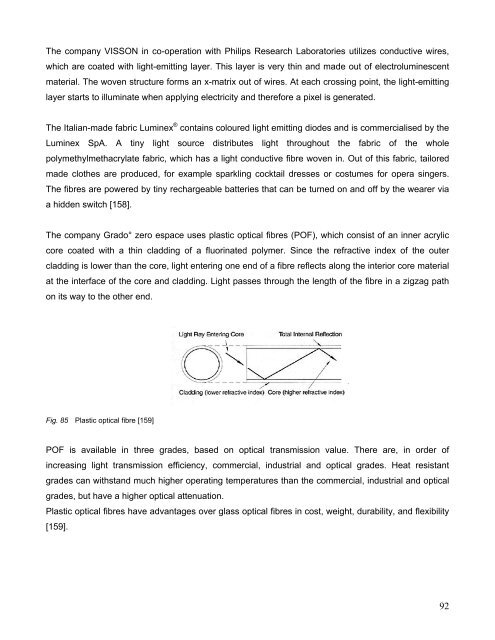Clevertex - Grado Zero Espace Srl
Clevertex - Grado Zero Espace Srl
Clevertex - Grado Zero Espace Srl
You also want an ePaper? Increase the reach of your titles
YUMPU automatically turns print PDFs into web optimized ePapers that Google loves.
The company VISSON in co-operation with Philips Research Laboratories utilizes conductive wires,<br />
which are coated with light-emitting layer. This layer is very thin and made out of electroluminescent<br />
material. The woven structure forms an x-matrix out of wires. At each crossing point, the light-emitting<br />
layer starts to illuminate when applying electricity and therefore a pixel is generated.<br />
The Italian-made fabric Luminex ® contains coloured light emitting diodes and is commercialised by the<br />
Luminex SpA. A tiny light source distributes light throughout the fabric of the whole<br />
polymethylmethacrylate fabric, which has a light conductive fibre woven in. Out of this fabric, tailored<br />
made clothes are produced, for example sparkling cocktail dresses or costumes for opera singers.<br />
The fibres are powered by tiny rechargeable batteries that can be turned on and off by the wearer via<br />
a hidden switch [158].<br />
The company <strong>Grado</strong>° zero espace uses plastic optical fibres (POF), which consist of an inner acrylic<br />
core coated with a thin cladding of a fluorinated polymer. Since the refractive index of the outer<br />
cladding is lower than the core, light entering one end of a fibre reflects along the interior core material<br />
at the interface of the core and cladding. Light passes through the length of the fibre in a zigzag path<br />
on its way to the other end.<br />
Fig. 85 Plastic optical fibre [159]<br />
POF is available in three grades, based on optical transmission value. There are, in order of<br />
increasing light transmission efficiency, commercial, industrial and optical grades. Heat resistant<br />
grades can withstand much higher operating temperatures than the commercial, industrial and optical<br />
grades, but have a higher optical attenuation.<br />
Plastic optical fibres have advantages over glass optical fibres in cost, weight, durability, and flexibility<br />
[159].<br />
92

















